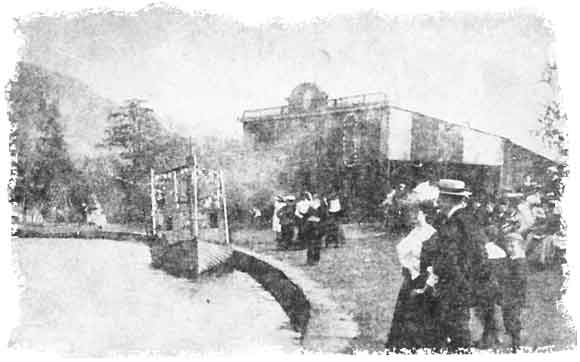These were particularly important for the public to enjoy, in an era before the widespread travelling and holidaying of today. The Calderdale area had a number of notable examples.
People's Park in Halifax boasted spectacular water features. The Sunny Vale Pleasure Gardens at Hipperholme offered attractions ranging from concerts to rides on a helter-skelter. Meanwhile, seeing exotic animals was only one part of an exciting day out at the Halifax Zoo in Exley.
Halifax zoo
The animals came in two by two.
It could be a surprise to some, but in the early 1900s, Halifax had its own zoo and amusement park. It was opened in May 1909 and was located at Chevinedge, Exley.
One week before the opening of the zoo, men were working well into the night in preparation for opening day. The idea was to find a representation of the world's species of animals. The zoo boasted an elephant, zebras, camel, monkeys, pythons and eagles amongst its stock of a thousand.

Exley was transformed on May 29th, the opening day. People flocked to the zoo, many taking advantage of the special tram service to the bottom of Exley Bank. Celebratory flags were hung at the zoo's entrance, the mansion and many neighbouring houses.
Over the opening Whitsuntide weekend, some forty thousand people visited the attraction.
As well as the animals, the zoo boasted many other attractions. One of these was the cinema, then referred to as the 'Electric Theatre'. It was said to be the first of its kind outside London.
Next to the cinema was the Fun Factory and the Hall of Mirrors. It also had a large skating rink and a miniature railway, very aptly called 'Little Elephant'. This transported visitors around the park.
The zoo became well known for its special attractions. Some of these reflected the growing fascination with flight. A month after it opened, Captain Spencer visited. He intended to go up five thousand feet in a balloon, then parachuting back to earth. He did this, although his landing at North Dean Wood was slightly off target!
Life at the zoo was not without its dramas. On one occasion, a wild boar leapt over the railings of its enclosure and attacked a woman. Reports at the time said that the woman fought off the boar with her umbrella! On another occasion, an elephant, who was a favourite with visitors, decided to break free of her chains. She was later found asleep on the front lawn of Chevinedge Mansion. In 1913, a grizzly bear was seen lumbering down Exley Bank, closely followed by the head keeper. The bear was later recaptured in Elland Wood.
During the First World War, it became evident that the zoo was losing its popularity. It was also becoming increasingly difficult to obtain food for the animals. In 1916, the animals were sold and the last advertisement for an attraction on the site was in 1917. The mansion was demolished in 1933 and houses were eventually built on the site of the zoo.
Sunny Vale Pleasure Gardens
Happy Days at Sunny Vale
Sunny Vale Pleasure Gardens were the brainchild of one Joseph Bunce, a native of London. Having married his Yorkshire wife, Sarah, they moved to a cottage at Wood Bottom Farm. The idea developed from the fact that Sarah and Joseph would cater for Sunday walkers passing the farm.
Joseph and his wife would put out tables and serve people with tea and cakes. Joseph moored four boats on a small pond nearby and erected swings for children to use.
Having purchased more land in 1880, the Pleasure Gardens were opened in 1883 at Hipperholme and proved to be a great attraction. In its heyday, Sunny Vale would attract around 100,000 visitors each year. Some arrived on foot, while others travelled by rail to Hipperholme station.
Sunny Vale had numerous attractions including boating on the two lakes, a maze and a helter-skelter. For the more energetic there was open-air dancing or roller skating.

Concerts were regularly held and rides could be enjoyed on the miniature railway, which was known as 'Baby Bunce'. Amusement tickets were priced at 1d each or 24 tickets for 1/6d. The famous tearoom seated 1,000 people and often served meals to over 4,000 customers per day. Later, it was used as a popular dance hall.
Pathways were lit-up and a huge firework display marked the end of each season. Joseph Bunce died in 1918, but the popularity of the gardens remained until the end of the Second World War. It then suffered a decline in visitors. This was partly due to the rise in popularity of places like Belle Vue and Blackpool's Pleasure Gardens. The Bunce family sold it in 1945 to Fred Thompson of Cleveleys.
In recent years, the site has been used for many purposes and sadly nothing remains of its former glory.
Online library catalogue